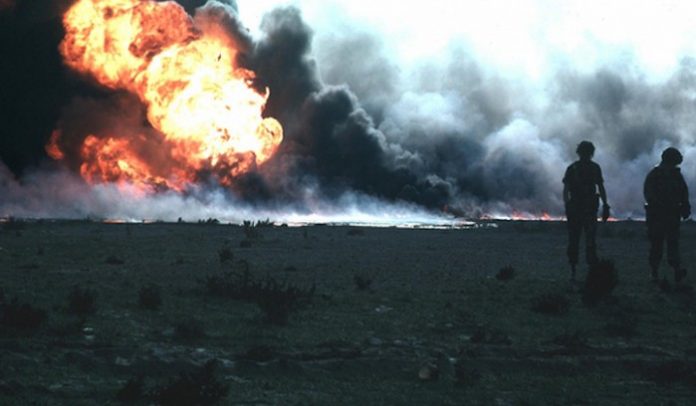Iraqi Invasion-an environmental catastrophe
During the seven-month long occupation of Kuwait by Iraqi forces from August 1990 to February 1991, imprisonment, torture and killing of those opposed to the regime, as well as the plunder and pilferage of the country’s assets, were widespread.
The memory of the martyrs who lost their lives during the invasion and occupation will no doubt live forever in the minds of their loved ones, but another lasting legacy of those dark days was the environmental catastrophe created by the deliberate burning of oil wells and the spewing of oil into the waters of the Arabian Gulf.
By early February, when it became apparent that the international coalition forces authorized by United Nations were preparing to roll back the invasion and push the aggressor out of Kuwait, orders came in from the highest levels of the Iraqi hierarchy to undertake a ‘scorched earth’ policy, by burning and destroying Kuwait’s infrastructure. But even long before January 1991, there were covert plans in place to systematically destroy Kuwait’s oil industry by setting fire to its oil wells in case of any attempt by the United States and its allies to launch an attack on Iraq.

It was in line with this plan that 789 productive oil wells were set ablaze in the span of a few days, causing catastrophic consequences to both the economy and ecology of Kuwait. As dense black clouds of soot from burning oil wells turned midday to midnight and the distant horizon turned orange from the glow of raging fires, the ecological landscape and environment of Kuwait began to undergo dramatic transformation.
By March 1991, initial assessment of the burning oil wells showed that more than six million barrels of oil were going up in flames per day. The amount of soot generated, estimated at nearly 3,400 metric tons per day, was also a major concern — one gram of soot can block-out two-thirds of the light falling over an area of eight to ten square meters. Scientists were of the opinion that burning of just two billion barrels of oil per day could generate a plume of smoke and soot that could cover over four million square kilometers.
Luckily, the plume of smoke that rose more than six kilometers into the atmosphere and traveled a distance of over 1,600 kilometers was short-lived. Clouds and precipitation in the atmosphere dissipated much of the smoke and by November 1991, the last of the burning oil wells had been capped. However, the scale of damage to the Kuwaiti economy and ecological environment was only beginning to be assessed.
Hundreds of kilometers of Kuwait desert were turned uninhabitable due to the formation of oil lakes and soot from burning wells. In 1993 more than 240 oil lakes had been discovered in the desert with the surrounding area transformed into semi-asphalt from the mixture of sand and oil residue. This effectively reduced nearly five percent Kuwait’s land area into a totally uninhabitable zone. Of even greater concern to the authorities was the effect on the Arabian Gulf from the vast amount of raw crude that had been deliberately spilled into its waters.
The Gulf already comprised one of the most fragile ecosystems on the planet, and prior to the Iraqi invasion this ecosystem was attempting to recover from the damage inflicted upon it during the 10-year Iran-Iraq War. As a result of the Iraqi scorched earth policy, it was estimated that 250 million gallons of oil — more than 20 times the amount spilled in the Exxon Valdez disaster in Alaska — seeped into the Gulf, causing irreparable harm to the biological diversity and physical integrity of the Gulf.
At its height, the oil slick extended over an area of 10,000 square km with anywhere between 500,000 to 750,000 cubic meters of oil believed to have been spilled into the Gulf. Oil also soaked over 700km of Saudi Arabia’s coastline. Due to the Gulf’s sluggish water circulation system, it was projected that it would take years before the oil could settle down or be swept away by the natural forces of water currents.
Another issue of grave concern arising from the oil spillage was the overwhelming dependence on the Gulf to provide drinking water to the region. Seventy to ninety percent of the populace depended on desalination plants for fresh-water supplies, and the oil spillage threatened the Gulf’s desalination plants, as well as other power plants and industrial facilities along the Gulf coast.
The fishing industry in the region was also deleteriously affected by the oil spillage into the Gulf waters. The oil disrupted the spawning of shrimps and fish and this affected the livelihood of many people in the area who relied on fishing as a subsistence activity. The spill also impacted the yield from these waters, which dropped significantly from the average 120,000 tons of marine life harvested each year. Another impact of the oil spillage was its effect on many endangered species, including green and hawksbill turtles, dugongs, whales, dolphins and the millions of migratory birds like cormorants and flamingoes that visit the Gulf each year.
Today, 27 years since the greatest man-made environmental catastrophe, the air, land and waters of the Gulf have gradually revived and rehabilitated, but the scars left behind from the invasion continue to haunt the minds of people who lived through those harrowing months.

















